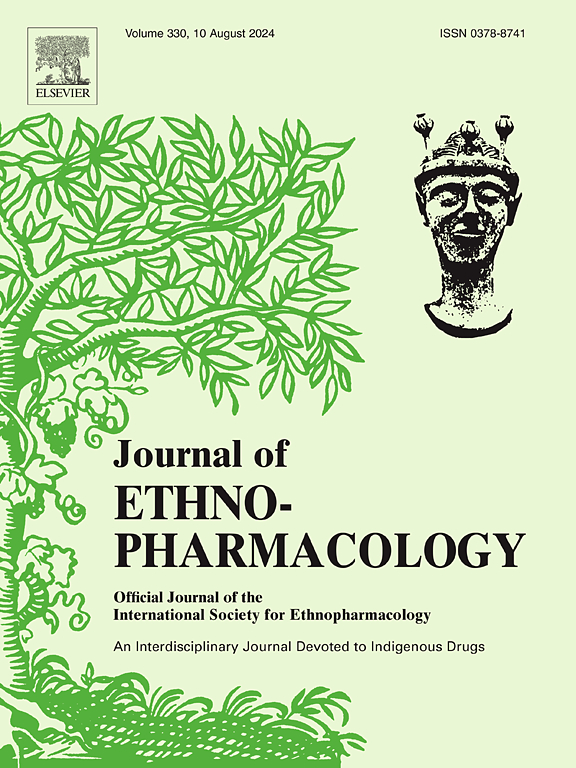Buyang Huanwu Decoction prevents hemorrhagic transformation after delayed t-PA infusion via inhibiting NLRP3 inflammasome/pyroptosis associated with microglial PGC-1α
IF 4.8
2区 医学
Q1 CHEMISTRY, MEDICINAL
引用次数: 0
Abstract
Ethnopharmacological relevance
Delayed tissue-type plasminogen activator (t-PA) thrombolysis, which has a restrictive therapeutic time window within 4.5 h following ischemic stroke (IS), increases the risk of hemorrhagic transformation (HT) and subsequent neurotoxicity. Studies have shown that the NLRP3 inflammasome activation reversely regulated by the PGC-1α leads to microglial polarization and pyroptosis to cause damage to nerve cells and the blood-brain barrier. The effect of Buyang Huanwu Decoction (BHD), a traditional Chinese medicine prescription widely used in the recovery of IS, on HT injury after delayed t-PA treatment had been found with clinical studies, while the underlying mechanisms are reminded to be further clarified.
Aim of the study
This study sought to investigate the therapeutic effect and the underlying mechanisms of BHD in ischemic rat brains with delayed t-PA treatment.
Materials and methods
The components of BHD extracts were identified by High Performance Liquid Chromatography (HPLC) and the effective components in the rat brains from BHD were analyzed by liquid chromatography-mass spectrometry (LC-MS). In vivo experiment was carried out by 5 h of middle cerebral artery occlusion (MCAO) following by t-PA infusion for 0.5 h plus reperfusion 19 h, while the in vitro BV2 cells were stimulated by lipopolysaccharide (LPS)-adenosine triphosphate (ATP) to activate microglia pyroptosis, of which the MCC950 (NLRP3 inhibitor) and NSA (GSDMD inhibitor) were adopted as reverse validation. PGC-1α siRNA was utilized to study the mechanisms of BHD against microglial polarization and pyroptosis in BV2 cells.
Results
HPLC analysis demonstrated the fingerprint of BHD with six reference standards (Hydroxysafflor yellow A, Calycosin-7-glucoside, Paeoniflorin, Formononetin, Ferulic acid and Amygdalin), the last two of which can be found in rat brains by LC-MS analysis. In the following experiments, we found the major discoveries as follow: (1) BHD improved the neurological outcomes, the structural integrity of the blood-brain barrier and the neuronal structure in HT rats with MCAO following by delayed t-PA infusion; (2) the presence of t-PA promoted the suppression of PGC-1α and the activation of microglial NLRP3 inflammasome and pyroptosis in the HT rats; (3) BHD promoted the transformation of microglia from M1 to M2 type for inhibiting inflammatory response; (4) BHD restrained NLRP3 inflammasome/pyroptosis activation in microglia, prevented the translocations of NF-κB into the nucleus, as well as enhanced microglia-specific PGC-1α in ischemic rats following t-PA delayed thrombolysis; (5) BHD suppressed NLRP3 inflammasome assembly and increased PGC-1α expression in the LPS-ATP-induced BV2 cells; (6) PGC-1α silencing withdrew the protective role of BHD against NLRP3 inflammasome/pyroptosis.
Conclusion
Mechanistically, BHD existed the protective effect against HT injury after delayed t-PA treatment through up-regulating microglial PGC-1α to inhibit NLRP3 inflammasome and pyroptosis, and serves as a potential adjuvant therapy for HT injury.

补阳还五汤通过抑制与小胶质细胞PGC-1α相关的NLRP3炎性体/焦亡,阻止t-PA延迟输注后的出血转化。
民族药理学相关性:延迟组织型纤溶酶原激活剂(t-PA)溶栓,在缺血性卒中(IS)后的4.5小时内具有限制性的治疗时间窗,增加了出血性转化(HT)和随后的神经毒性的风险。研究表明,受PGC-1α反向调控的NLRP3炎性小体激活可导致小胶质细胞极化和焦亡,对神经细胞和血脑屏障造成损伤。补阳还五汤是IS恢复期广泛使用的中药方剂,临床研究发现补阳还五汤对延迟t-PA治疗后HT损伤的作用,但其作用机制有待进一步阐明。研究目的:本研究旨在探讨延迟t-PA治疗缺血性大鼠脑BHD的疗效及其机制。材料与方法:采用高效液相色谱法(HPLC)对茯苓提取物进行成分鉴定,采用液相色谱-质谱联用技术(LC-MS)对茯苓提取物大鼠脑中的有效成分进行分析。体内实验采用大脑中动脉闭塞(MCAO) 5 h, t-PA输注0.5 h,再灌注19 h的方法,体外实验采用脂多糖(LPS)-三磷酸腺苷(ATP)刺激BV2细胞,激活小胶质细胞焦凋亡,其中采用MCC950 (NLRP3抑制剂)和NSA (GSDMD抑制剂)进行反向验证。利用PGC-1α siRNA研究BHD抗BV2细胞小胶质细胞极化和焦亡的机制。结果:高效液相色谱法与羟基红花黄A、毛蕊花苷-7-葡萄糖苷、芍药苷、芒柄花素、阿魏酸、苦杏仁苷6种标准品指纹图谱一致,后2种标准品经LC-MS分析可在大鼠脑中找到。在接下来的实验中,我们发现:(1)BHD改善了MCAO HT大鼠的神经预后,改善了血脑屏障的结构完整性和神经元结构;(2) t-PA的存在促进HT大鼠PGC-1α的抑制和小胶质NLRP3炎性小体的激活及焦亡;(3) BHD促进小胶质细胞由M1型向M2型转化,抑制炎症反应;(4) BHD抑制小胶质细胞NLRP3炎性体/焦亡活化,阻止NF-κB易位入核,并增强t-PA延迟溶栓后缺血大鼠小胶质细胞特异性PGC-1α;(5)在lps - atp诱导的BV2细胞中,BHD抑制NLRP3炎性体的组装,增加PGC-1α的表达;(6) PGC-1α沉默退出了BHD对NLRP3炎性体/焦亡的保护作用。结论:从机制上看,BHD通过上调小胶质细胞PGC-1α抑制NLRP3炎性体和焦亡,对延迟t-PA治疗后HT损伤具有保护作用,可能是HT损伤的辅助治疗方法。
本文章由计算机程序翻译,如有差异,请以英文原文为准。
求助全文
约1分钟内获得全文
求助全文
来源期刊

Journal of ethnopharmacology
医学-全科医学与补充医学
CiteScore
10.30
自引率
5.60%
发文量
967
审稿时长
77 days
期刊介绍:
The Journal of Ethnopharmacology is dedicated to the exchange of information and understandings about people''s use of plants, fungi, animals, microorganisms and minerals and their biological and pharmacological effects based on the principles established through international conventions. Early people confronted with illness and disease, discovered a wealth of useful therapeutic agents in the plant and animal kingdoms. The empirical knowledge of these medicinal substances and their toxic potential was passed on by oral tradition and sometimes recorded in herbals and other texts on materia medica. Many valuable drugs of today (e.g., atropine, ephedrine, tubocurarine, digoxin, reserpine) came into use through the study of indigenous remedies. Chemists continue to use plant-derived drugs (e.g., morphine, taxol, physostigmine, quinidine, emetine) as prototypes in their attempts to develop more effective and less toxic medicinals.
文献相关原料
公司名称
产品信息
索莱宝
phosphorylate inhibitor
索莱宝
mixture of 1% protease and a phosphorylate inhibitor
 求助内容:
求助内容: 应助结果提醒方式:
应助结果提醒方式:


